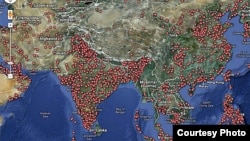Arizona State University atmospheric scientist Kevin Gurney is mapping carbon dioxide emissions for the entire planet and he wants you to help.
Data is sketchy
Power plants account for more than 40 percent of the carbon dioxide emissions in the atmosphere. Gurney wants more information on the 25,000 plants around the world.
He says good data exists for the United States, Canada, India and the European Union, but estimates for the rest of the world are sketchy. “In fact, it’s so inaccurate that it is really insufficient for the type of science that we’re trying to do,” he said.
Gurney studies how carbon dioxide moves around the earth and affects global climate change.
Locate your power plant
His project is called Ventus, which is Latin for ‘wind.’ He has set up a website where you can zoom in and drop a virtual pin on the power plant map that shows your location. Your job then is to provide an accurate address and other details about the plant.
“We just need the amount of electricity generated at a power plant,” Gurney explains. “We also need to know the primary fuel. And with those two things we can actually create a better estimate of CO2 emissions than we do right now.”
CO2 emissions map
Internal checks are built into the Ventus system to monitor the accuracy and consistency of information. Gurney says the uploaded data will be included in a virtual map of CO2 emissions in 10-kilometer squares across the planet.
“We will produce the emissions on a map, every hour, every year, he notes. “We will use that within models of climate change to more accurately characterize emissions, greenhouse gas concentration and the projections of those concentrations into the future.”
The first version of the map will go online within the next several months and will be updated as information is received. Gurney hopes it will help to better inform policy makers and the public.
He also expects citizens engaged with the project to become advocates of change.
“I think that the power of bringing that information to the scale at which people live, allowing them to see it on a map, contribute information about this real physical thing that is around them, tends to lessen the abstraction of this problem. It makes it more real.”
Become the Supreme Power Plant Emissions Guru
Gurney says that connection makes it easier to take action.
Gurney encourages people to register on the Ventus website. The citizen scientist who provides the most usable information will be named Supreme Power Plant Emissions Guru, an honor which comes with a trophy and listing as a co-author on a scientific paper about the project.
Data is sketchy
Power plants account for more than 40 percent of the carbon dioxide emissions in the atmosphere. Gurney wants more information on the 25,000 plants around the world.
He says good data exists for the United States, Canada, India and the European Union, but estimates for the rest of the world are sketchy. “In fact, it’s so inaccurate that it is really insufficient for the type of science that we’re trying to do,” he said.
Gurney studies how carbon dioxide moves around the earth and affects global climate change.
Locate your power plant
His project is called Ventus, which is Latin for ‘wind.’ He has set up a website where you can zoom in and drop a virtual pin on the power plant map that shows your location. Your job then is to provide an accurate address and other details about the plant.
“We just need the amount of electricity generated at a power plant,” Gurney explains. “We also need to know the primary fuel. And with those two things we can actually create a better estimate of CO2 emissions than we do right now.”
CO2 emissions map
Internal checks are built into the Ventus system to monitor the accuracy and consistency of information. Gurney says the uploaded data will be included in a virtual map of CO2 emissions in 10-kilometer squares across the planet.
“We will produce the emissions on a map, every hour, every year, he notes. “We will use that within models of climate change to more accurately characterize emissions, greenhouse gas concentration and the projections of those concentrations into the future.”
The first version of the map will go online within the next several months and will be updated as information is received. Gurney hopes it will help to better inform policy makers and the public.
He also expects citizens engaged with the project to become advocates of change.
“I think that the power of bringing that information to the scale at which people live, allowing them to see it on a map, contribute information about this real physical thing that is around them, tends to lessen the abstraction of this problem. It makes it more real.”
Become the Supreme Power Plant Emissions Guru
Gurney says that connection makes it easier to take action.
Gurney encourages people to register on the Ventus website. The citizen scientist who provides the most usable information will be named Supreme Power Plant Emissions Guru, an honor which comes with a trophy and listing as a co-author on a scientific paper about the project.






